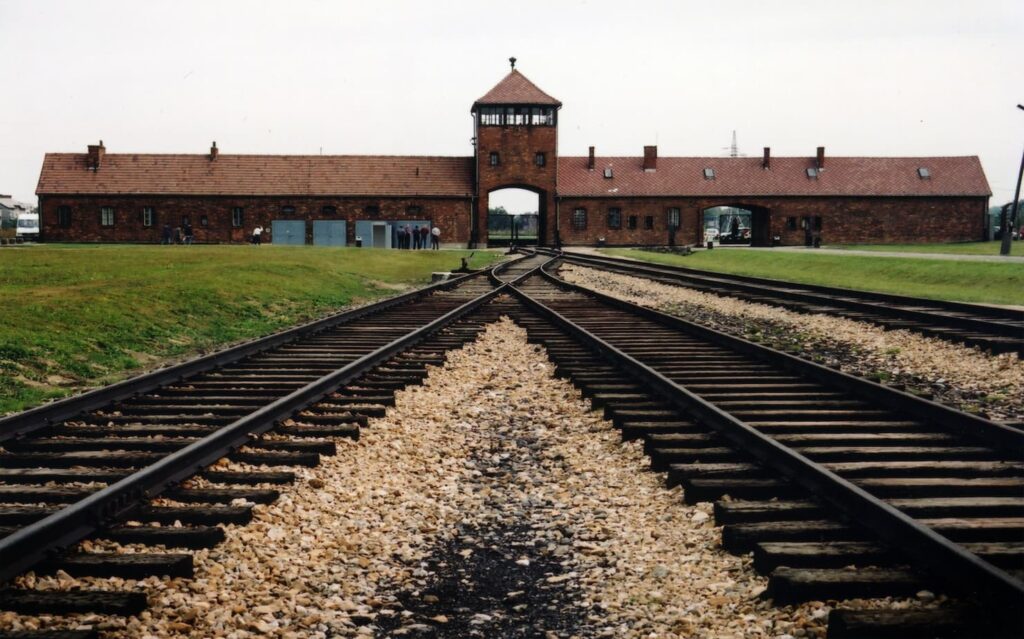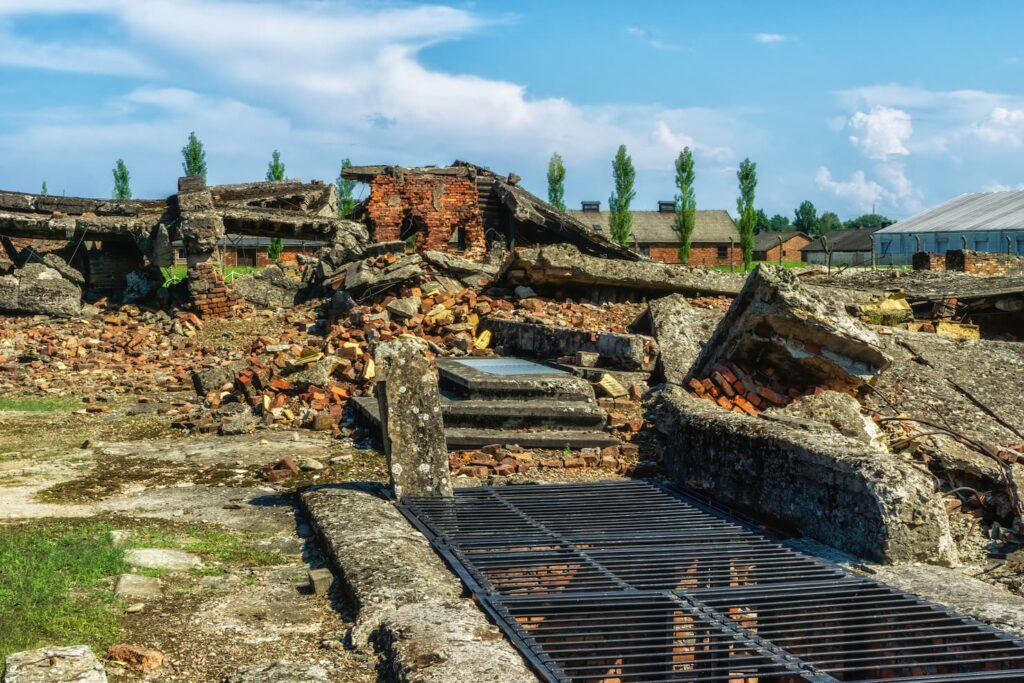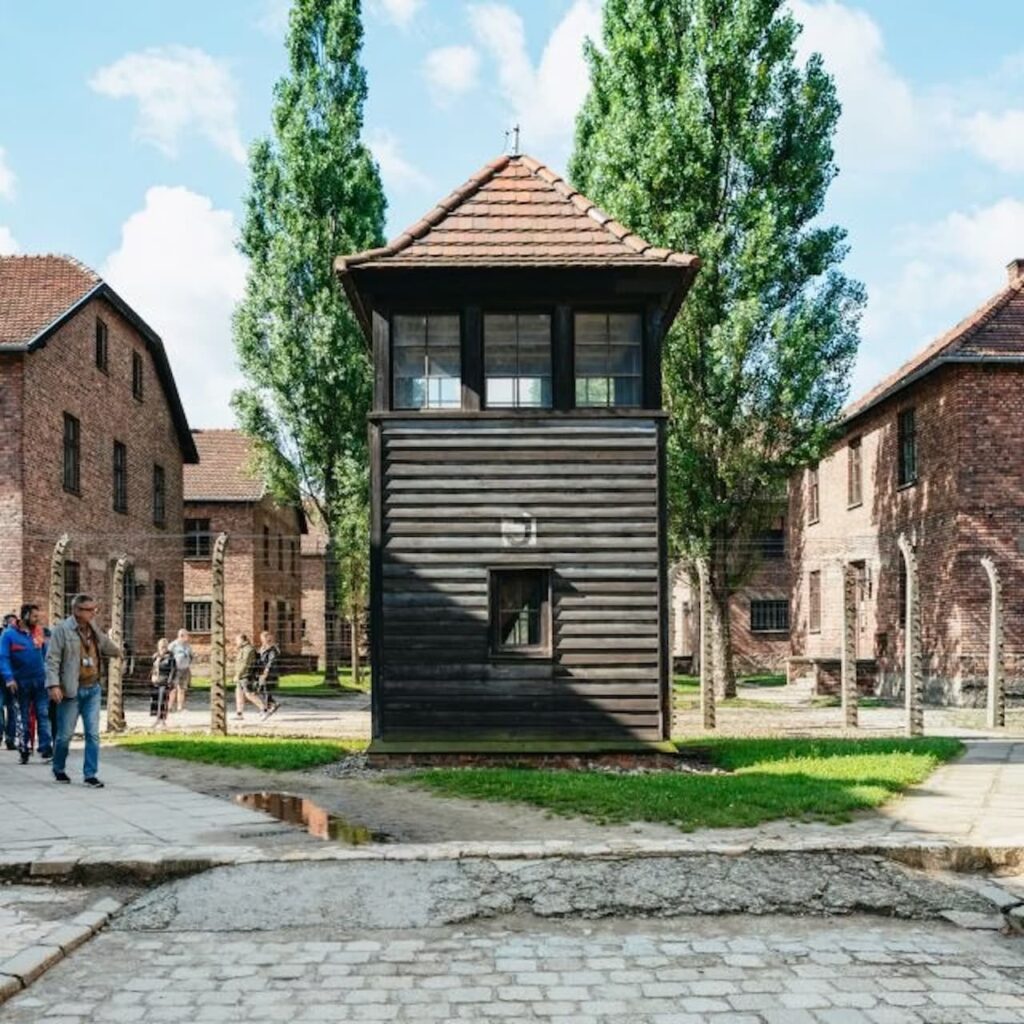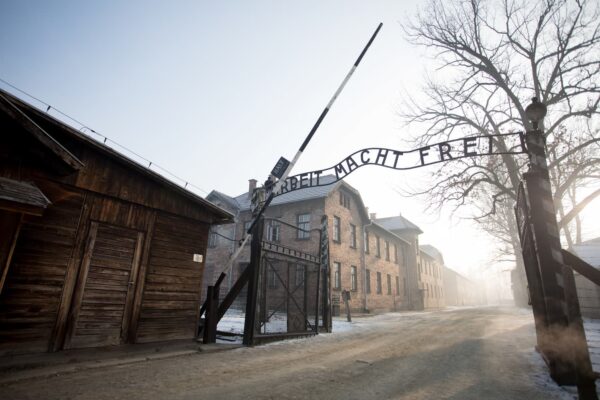Are you planning to visit Auschwitz concentration camp with your children?
Then this guide is for you! In this article we will see how to get to the historical site and all the useful information you need for a complete visit.
By the end of the reading you will also know how best to let your children experience it so they can get the most out of the teaching.
The two extermination camps, Auschwitz I and Auschwitz II – Birkenau can be visited virtually year-round, but it is good to make arrangements if you want to go with minors.
Pay attention! As a first thing, in fact, we would like to strongly advise you to book a priority ticket with which you can directly access the camp-museum avoiding long lines. More importantly just in case of access with children, since the visit takes approximately three and a half hours, it is good to be able to enter the concentration camp immediately to avoid them additional waiting time!

Ticket to Auschwitz-Birkenau (skip the line) with guided tour and transportation from Krakow
Purchase online. Choose the time of your choice. Visit the prisoner barracks, infamous gas chambers and crematoria on your own.
You can cancel for free up to the day before your visit.
Table of Contents
How to get to Auschwitz with children
You will have many options for reaching the Concentration Camp depending on your preferences and those of your little travelers! If you wish to move by public transportation, the city from which Auschwitz is most easily accessible is Krakow. From here, in fact, you can reach the camp-museum either by train or bus.
As far as rail transport is concerned, you will have to start from the central station, Krakow Główny, from which you will travel for a distance that can vary between 48 and 80 minutes depending on the type of train you choose and the consequent number of stations where it will be stopping.
With the bus, on the other hand, the journey time will be about an hour and a half. Both options allow you to travel economically and rather smoothly, even for your children.
However, if you want more autonomy and to manage the trip according to the needs of the little ones, you can also reach the concentration camp very easily by car: you will travel on a half toll road and arrive at your destination in about an hour and twenty minutes, depending on traffic conditions.
If your children are impatient with travel, you can consider planning your visit starting from Katowice, a city with an airport: from here by car, in fact, 45 minutes will be enough!
Also consider that the camp-museum has a parking lot located near the entrance.
Departing from Katowice, if you are planning a visit equipped with every comfort, you can also reach the Auschwitz concentration camp by cab, at a cheaper price than departing from Krakow, from which it is still possible to take advantage of this option, again starting from the city center and taking advantage of the radio cab.
As far as public transportation is concerned, from Katowice you can travel by train and you will have to make a change to get to your destination station, with a travel time of about an hour to which the wait for the connection should be added.
If you have children with you and wish to reach the camp from Warsaw, we recommendrenting a car, which will allow you to arrive at your destination with a trip of about three and a half hours; by public transport, on the other hand, you will necessarily have to reach Krakow and then move to the camp-museum, so the duration of the transfer by train varies from 4 and a half to five and a half hours, while by bus it is more than 6 hours.

Ticket to Auschwitz-Birkenau (skip the line) with guided tour and transportation from Krakow
Purchase online. Choose the time of your choice. Visit the prisoner barracks, infamous gas chambers and crematoria on your own.
You can cancel for free up to the day before your visit.
Visit to Auschwitz with children: useful info
A visit to the Auschwitz concentration and extermination camp is an incredible opportunity for growth and reflection! To get the most out of this experience, it is good to be aware of some useful information to organize in the best possible way.
First of all, it is good to remember the importance of the place, so it is a good idea to dress appropriately, avoiding clothes that are too short and low-cut, or garments with excessively bright colors.
If you are traveling with children, it is good to prepare them by letting them know that during the visit you should avoid noise out of respect for the areas you are visiting and to move away from their parents for their safety.
If you are planning to visit outside the summer months, remember to dress appropriately, especially the little ones, given the cold temperatures in Poland.
Also, it is good to wear comfortable shoes considering the length of the visit and the uneven terrain of some areas.
Backpacks or bags measuring 30x20x10 cm maximum may fit inside the camp.
You will be able to both film and photograph all areas of the camp, with the exception of block 4 and 11, but strictly without flash.
One of the most important pieces of information you need to be aware of is thereservation requirement: you must reserve your entrance to the camp in advance. The procedure is free, but you will be able to add paid services such as earphones or an expert guide: you will also be able to use the escort in your own language, but you will have to book well in advance because places are limited.
We highly recommend this option for a truly complete experience. In addition, also for a fee, you can attend the screening of the documentary about the liberation of the camp, but consider that some of the images may offend the sensibilities of the little ones.
As for the opening hours, the camp is open year-round except for Easter, Christmas and New Year’s Day. However, the hours vary depending on the period:
- December: 8-14
- January and November: 8-15
- February: 8-16
- March and October: 8-17
- April, May and September: 8-18
- June, July and August: 8-19
Please note: the second time does not indicate the closing of the camp, but the last possible entrance. after which you can stay inside the Auschwitz camp-museum only for an hour and a half. For example, in February you can enter at 4 p.m., but in this case you can stay inside the camp only until 5:30 p.m. We do not recommend entering at the end of the allowed hours because you will not have the necessary hours for a full visit.
Since you intend to access the concentration camp with your children, we suggest that you plan your visit in the warmer months, considering that Polish winter temperatures are really prohibitive and difficult to bear, especially for young children.
Finally, we recommend using the shuttles that connect the Auschwitz I camp with Auschwitz II – Birkenau: although it is also possible to cover the route on foot, it is best to use this means given the length of the visit so as not to tire the little ones further. In summer (between April and October) you can count on a bus every 15 minutes, and in winter (November-March) every half hour.
Prepare the child psychologically
The concentration camp is a place that can have a very strong psychological impact, both on adults and, even more so, on children. When planning this visit with your children, it is good to make sure that they can bear it emotionally.
Therefore, it is advisable to prepare them by making them understand the importance of the place and by making them aware of some historical information to put the visit in context. Also, it might be a good choice to instill curiosity in your children: for example, you could tell them some stories of the most famous deportees, such as Anne Frank or Primo Levi.
Depending on the age of the child in question, you could tackle some readings on the subject together. We also suggest two readings to do together with your children, which are perhaps easier for younger children as well: the comic diary of Anne Frank, turned into a graphic novel by director Folman and illustrator Polonsky; and Maus by Art Spiegelman, a story also in comic form where the deportees are impersonated by mice and the Nazis, on the other hand, are cats.
In any case, only the parent can tell whether the child is actually ready for this experience and choose the best course to prepare him or her for the visit.

Ticket to Auschwitz-Birkenau (skip the line) with guided tour and transportation from Krakow
Purchase online. Choose the time of your choice. Visit the prisoner barracks, infamous gas chambers and crematoria on your own.
You can cancel for free up to the day before your visit.
Short guide for visiting Auschwitz for children

Entrance to Auschwitz-Birkenau – Photo ID 239172174 © Francesco Valenti | Dreamstime.com
The Auschwitz-Birkenau concentration camp was one of the places where Nazi cruelty was made explicit at its worst. Its construction began in May 1940 and it remained active until January 1945, even counting about one and a half million inmates. Today, it is possible to visit both camps because, as Primo Levi said, “If understanding is impossible, knowing is necessary.”
In fact, during the visit you will be able to explore the various blocks of Auschwitz I: you will see with your own eyes the personal belongings that belonged to the inmates, the barracks in which they slept and their uniforms, the very poor sanitary facilities, the gas chambers and crematoria used to carry out the tragic genocide, and much more.
Birkenau, on the other hand, houses partial facilities because of the SS’s attempt to eliminate evidence of the extermination. Here, too, it is possible to visit the deportees’ barracks, as well as the railway yard where trains arrived with the deportees. Perhaps the tribute that can be paid to the “submerged” that Primo Levi always talked about is precisely to pass on the memory even to the youngest, to the new generations. Read on to learn how best to do this.
Recommended points of interest for children
Both Auschwitz I and Auschwitz II – Birkenau give very intense emotions, given their strong historical and cultural relevance. Despite this, or perhaps because of this, if you are traveling with children, it is a good idea to consider what can be most easily understood and what, perhaps, is best avoided.
As for Auschwitz, it is good to explain to them the meaning of the famous inscription “Arbeit macht frei,” or “work makes you free.”

ID 41362760 | Auschwitz © Danilo Mongiello | Dreamstime.com
Here you can tell them the story of the “B” backwards, to pass on an important lesson: It was in fact a prisoner who forged the inscription, forced by the SS. With that letter placed below, he wanted to convey his strong dissent to the regime and the nature of the Lager.
It is also recommended to show them the objects of the prisoners in Block 5: in fact, glasses, combs, shaving brushes, suitcases, shoes, etc. were seized from them.

Glasses of prisoners in Auschwitz concentration camp – Photo ID 274351760 © Sergii Figurnyi | Dreamstime.com
You will have the opportunity to show your children the anguish suffered by the prisoners and also to make them understand that indeed so many people were forced into this sad ordeal, explaining to them the fear they felt when faced with violent people after being deprived of every object they held dear.
It is also possible to visit Block 7, so that they can understand the very harsh conditions in which the deportees were forced to live, in worn-out barracks and bunks with poor sanitary conditions.

Dormitories in Auschwitz – Photo ID 134865240 © Golasza | Dreamstime.com
As for Block 4, it will be possible to see numerous used canisters of Ziklon B gas, i.e., the gas used in the gas chambers that led to the death of so many prisoners: we recommend explaining in an appropriate way, depending on the age and sensitivity of the child, what happened in this sad place, perhaps avoiding the visit inside the gas chambers and crematoriums, which are really very impactful.
As for Birkenau, however, the visit takes place in a different way: few structures survived here, so you will be in more open spaces. You will have the opportunity to show your children the train tracks in which the deported prisoners arrived, crammed in: again we suggest, depending on the sensitivity of the little visitor, explaining how these transports took place and the sad historical importance of this train yard.

Train to Auschwitz-Birkenau – Photo ID 313381457 | Auschwitz © Alexey Fedorenko | Dreamstime.com
In Birkenau, too, you can visit some of the barracks that remained after the Nazis attempted to eliminate evidence of extermination: some made of wood and others of masonry, they stood directly on the ground so that, often, the floor became a swampy expanse.

Ruins of a destroyed gas chamber in Birkenau – Photo ID 271443977 | Auschwitz © Atosan | Dreamstime.com
Points of interest to consider carefully
Because of the strong emotional impact of certain sections of the camp, we feel that we do not recommend visiting certain blocks if you are traveling in the company of particularly young and/or sensitive children.
For example, we feel that, for younger children, it might be too burdensome to observe the gas chambers and crematoria: if it is already virtually impossible for adults to accept such cruelty, for a child it could be truly disturbing.
The sight of inmates’ hair and the latticework woven with it present in Block 4, as well as photos depicting camp prisoners undernourished and steeped in suffering, might also prove too challenging.
We suggest, moreover, that the in-depth study of Mengele and his atrocious experiments covered in Block 10 be omitted: we feel it is really inappropriate and difficult for a child to explain, considering the brutality of such pseudo-experiments more akin to torture.
We also advise against the use of earphones for children under the age of 10 in order to avoid overly explicit and crude explanations.
As for the guides, on the other hand, they are accustomed to and prepared for the presence of children inside the camp and will know how best to preserve them, without, however, renouncing to pass on to them the best possible teaching: this is why we remind you that it is strongly recommended to make use of an experienced chaperone.
Finally, the Wall of Death between Block 10 and 11, the cells in Block 11 in which prisoners were held and inside which they were often tortured and left to die, and Room 4 in Block 6 dedicated to children deported to Auschwitz in which, perhaps, a young visitor might risk too strong an identification.
Visit Auschwitz with children: Frequently asked questions
Admission is not forbidden for children and there is no age limit, however, given the strong emotional impact resulting from the visit, it may not be appropriate for young children. It is recommended to come to Auschwitz with prior preparation and especially to leave out certain parts of the camp so that they can make the best of it without being emotionally affected by what they will visit. The visit is not recommended for children under the age of 14.
Yes, you can visit Auschwitz with a stroller, but you are not allowed to enter with other overly bulky luggage. However, in the dormitories, access with strollers is not allowed, so you will have to leave it outside in order to visit.
To visit the concentration and extermination camp, it is mandatory to reserve admission, without which you cannot gain access. You will be able to reserve admission free of charge, but it is good to move well in advance. However, we always recommend that you buy a priority ticket to avoid queues and enlist the help of an experienced guide to get the most out of the experience.
The city of Kraków is about 70 km from Oświęcim, the town that is home to the Auschwitz-Birkenau concentration camp.
The time varies depending on the city of departure and the means of transportation used. From Krakow you can reach Auschwitz in an hour and a half by bus or an hour and twenty by car or cab depending on traffic conditions. By train, on the other hand, the journey time varies depending on the train you choose, and ranges from a minimum of 48 minutes to a maximum of one hour and twenty.If you wish to reach the camp from Katowice, the nearest city with an airport, you can do so by car or cab in 45 minutes, while it will take you one hour by train, to which the wait for the necessary connection should be added.Finally, you can also get to the Auschwitz camp-museum from Warsaw, which is approximately 370 kilometers away. By car or cab you will be on the road for about three and a half hours, varying according to traffic conditions. If you prefer public transportation, from Warsaw you will first have to move to Krakow and then to Auschwitz: for this by train you will take from 4½ to 5½ hours, and by bus even more than six hours.
Click here to find out how to tell elementary school children about the Holocaust.
Full visit to Auschwitz-Birkenau with children: Conclusions
Here we come to the end of our guide on how to visit Auschwitz with your children.
We looked together at some important information about the concentration camp and how to get there from the main cities: Krakow, Warsaw, Katowice.
As you have seen, you have several options to choose from, depending on whether you prefer a cheaper trip or a more comfortable one and especially to make the journey as easy as possible for the little ones.
We have also seen some useful tips for preparing young visitors in the best possible way and especially the tricks for an exploration of Auschwitz-Birkenau that is as engaging and enriching as possible, but at the same time preserving children from the crudest events that took place inside the Lager.
Finally, I have answered the most frequently asked questions from our readers and those who wish to visit the concentration camp in the company of their children; however, if you still have questions, we look forward to seeing you in the comments below!
In conclusion, I would like to remind you that it is highly recommended to book priority admission in advance to avoid the very long lines at the camp ticket offices.
Also, don’t forget to book a guided tour as well ! Only in this way will you be able to take advantage of an experienced escort inside the various blocks of Auschwitz who can explain both you and your children the history of the museum-camp.
This is the only way not to run the risk of missing something.

Ticket to Auschwitz-Birkenau (skip the line) with guided tour and transportation from Krakow
Buy online. Choose the time of your choice. Visit the prisoner barracks, infamous gas chambers and crematoria on your own.
You can cancel for free up to the day before your visit.
Cover photo: ID 41199433 | Auschwitz © Simon Thomas | Dreamstime.com




